2007 ISUZU KB P190 sensor
[x] Cancel search: sensorPage 4403 of 6020

TRANSMISSION CONTROL SYSTEM (JR405E) 7A2-119
Z2: Mode Lamp (Power Drive or 3rd Start) Does Not Turn On
Z3: Mode Lamp (Power Drive or 3rd Start) Does Not Turn Off
Z4: A/T Oil Temperature Lamp Turns On
Z5: Selector Lever Feeling is Faulty
Z6: Poor Fuel Consumption
Checks Action
Definition:
Mode lamp on the instrument panel (IP) cluster does not turn ON even though the switch is ON.
Diagnosis Hints • Faulty mode switch circuit.
• Faulty mode switch.
• Faulty lamp control circuit.
• Faulty IP cluster.
Checks Action
Definition:
Mode lamp on the instrument panel cluster does not turn OFF even though the switch is OFF.
Diagnosis Hints • Faulty mode switch circuit.
• Faulty mode switch.
• Faulty lamp control circuit.
• Faulty IP cluster.
Checks Action
Definition:
A/T oil temperature lamp turns On sometimes.
Diagnosis Hints • If the fluid temperature increases to 135°C (275 °F), the TCM illuminates
A/T Oil Temp lamp on the instrument panel cluster. When the fluid
temperature deceases below 125 °C (257 °F), the lamp goes off.
• When the vehicle is stuck in the mud or continues to accelerate under overload, transmission fluid temperature increases and lamp may be
turned On.
• If the lamp is On under usual conditions, following causes are suspected. - Transmission fluid level has increased for some fault. Refer to category No. “Z1: Transmission Overheat”.
- Skewed transmission fluid temperature (TFT) sensor.
Checks Action
Definition:
Selector lever feeling is faulty.
Diagnosis Hints • Inspect the selector lever cable for misadjusting or disordering.
• Faulty manual plate.
Checks Action
Definition:
Poor fuel consumption.
Diagnosis Hints The same causes as in category No. “C1 - C8: Engine Race Up (Slipping)” are
suspected.
BACK TO CHAPTER INDEX
TO MODEL INDEX
ISUZU KB P190 2007
Page 4406 of 6020
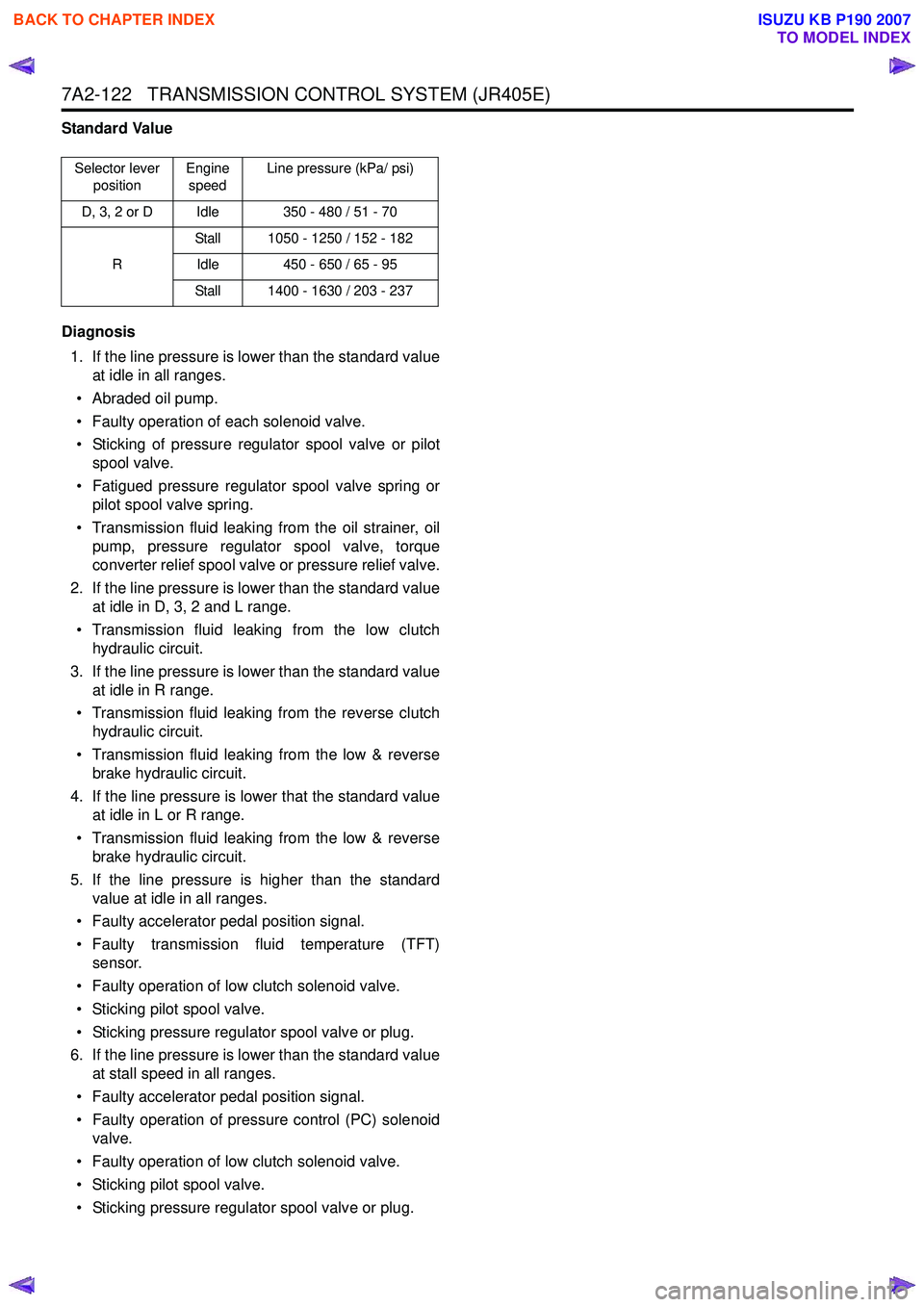
7A2-122 TRANSMISSION CONTROL SYSTEM (JR405E)
Standard Value
Diagnosis 1. If the line pressure is lower than the standard value at idle in all ranges.
• Abraded oil pump.
• Faulty operation of each solenoid valve.
• Sticking of pressure regulator spool valve or pilot spool valve.
• Fatigued pressure regulator spool valve spring or pilot spool valve spring.
• Transmission fluid leaking from the oil strainer, oil pump, pressure regulator spool valve, torque
converter relief spool valve or pressure relief valve.
2. If the line pressure is lower than the standard value at idle in D, 3, 2 and L range.
• Transmission fluid leaking from the low clutch hydraulic circuit.
3. If the line pressure is lower than the standard value at idle in R range.
• Transmission fluid leaking from the reverse clutch hydraulic circuit.
• Transmission fluid leaking from the low & reverse brake hydraulic circuit.
4. If the line pressure is lower that the standard value at idle in L or R range.
• Transmission fluid leaking from the low & reverse brake hydraulic circuit.
5. If the line pressure is higher than the standard value at idle in all ranges.
• Faulty accelerator pedal position signal.
• Faulty transmission fluid temperature (TFT) sensor.
• Faulty operation of low clutch solenoid valve.
• Sticking pilot spool valve.
• Sticking pressure regulator spool valve or plug.
6. If the line pressure is lower than the standard value at stall speed in all ranges.
• Faulty accelerator pedal position signal.
• Faulty operation of pressure control (PC) solenoid valve.
• Faulty operation of low clutch solenoid valve.
• Sticking pilot spool valve.
• Sticking pressure regulator spool valve or plug.
Selector lever position Engine
speed Line pressure (kPa/ psi)
D, 3, 2 or D Idle 350 - 480 / 51 - 70
R Stall 1050 - 1250 / 152 - 182
Idle 450 - 650 / 65 - 95
Stall 1400 - 1630 / 203 - 237
BACK TO CHAPTER INDEX
TO MODEL INDEX
ISUZU KB P190 2007
Page 4419 of 6020
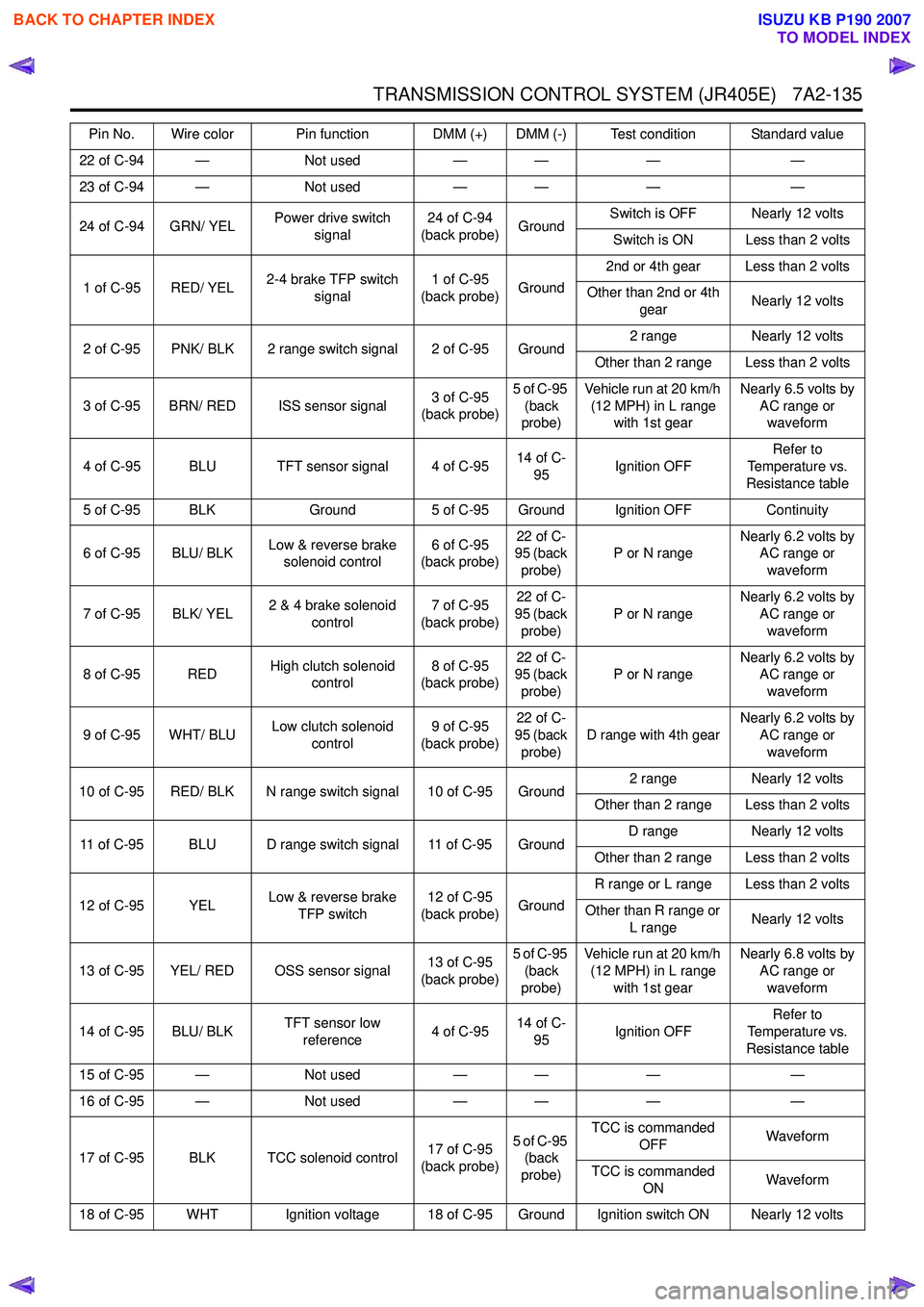
TRANSMISSION CONTROL SYSTEM (JR405E) 7A2-135
22 of C-94 —Not used— — ——
23 of C-94 — Not used— — ——
24 of C-94 GRN/ YEL Power drive switch
signal 24 of C-94
(back probe) GroundSwitch is OFF Nearly 12 volts
Switch is ON Less than 2 volts
1 of C-95 RED/ YEL 2-4 brake TFP switch
signal 1 of C-95
(back probe) Ground2nd or 4th gear Less than 2 volts
Other than 2nd or 4th gear Nearly 12 volts
2 of C-95 PNK/ BLK 2 range switch signal 2 of C-95 Ground 2 range
Nearly 12 volts
Other than 2 range Less than 2 volts
3 of C-95 BRN/ RED ISS sensor signal 3 of C-95
(back probe) 5 of C-95
(back
probe) Vehicle run at 20 km/h
(12 MPH) in L range with 1st gear Nearly 6.5 volts by
AC range or waveform
4 of C-95 BLU TFT sensor signal 4 of C-95 14 of C-
95 Ignition OFF Refer to
Temperature vs.
Resistance table
5 of C-95 BLK Ground5 of C-95 Ground Ignition OFF Continuity
6 of C-95 BLU/ BLK Low & reverse brake
solenoid control 6 of C-95
(back probe) 22 of C-
95 (back
probe) P or N range
Nearly 6.2 volts by
AC range or
waveform
7 of C-95 BLK/ YEL 2 & 4 brake solenoid
control 7 of C-95
(back probe) 22 of C-
95 (back
probe) P or N range
Nearly 6.2 volts by
AC range or
waveform
8 of C-95 RED High clutch solenoid
control 8 of C-95
(back probe) 22 of C-
95 (back
probe) P or N range
Nearly 6.2 volts by
AC range or
waveform
9 of C-95 WHT/ BLU Low clutch solenoid
control 9 of C-95
(back probe) 22 of C-
95 (back
probe) D range with 4th gear
Nearly 6.2 volts by
AC range or
waveform
10 of C-95 RED/ BLK N range switch signal 10 of C-95 Ground 2 range
Nearly 12 volts
Other than 2 range Less than 2 volts
11 of C-95 BLU D range switch signal 11 of C-95 Ground D range
Nearly 12 volts
Other than 2 range Less than 2 volts
12 of C-95 YEL Low & reverse brake
TFP switch 12 of C-95
(back probe) GroundR range or L range Less than 2 volts
Other than R range or L range Nearly 12 volts
13 of C-95 YEL/ RED OSS sensor signal 13 of C-95
(back probe) 5 of C-95
(back
probe) Vehicle run at 20 km/h
(12 MPH) in L range with 1st gear Nearly 6.8 volts by
AC range or waveform
14 of C-95 BLU/ BLK TFT sensor low
reference 4 of C-9514 of C-
95 Ignition OFF Refer to
Temperature vs.
Resistance table
15 of C-95 — Not used— — ——
16 of C-95 — Not used— — ——
17 of C-95 BLK TCC solenoid control 17 of C-95
(back probe) 5 of C-95
(back
probe) TCC is commanded
OFF Waveform
TCC is commanded ON Waveform
18 of C-95 WHT Ignition voltage 18 of C-95 Ground Ignition switch ON Nearly 12 volts Pin No. Wire color Pin function DMM (+) DMM (-) Test condition Standard value
BACK TO CHAPTER INDEX
TO MODEL INDEX
ISUZU KB P190 2007
Page 4421 of 6020
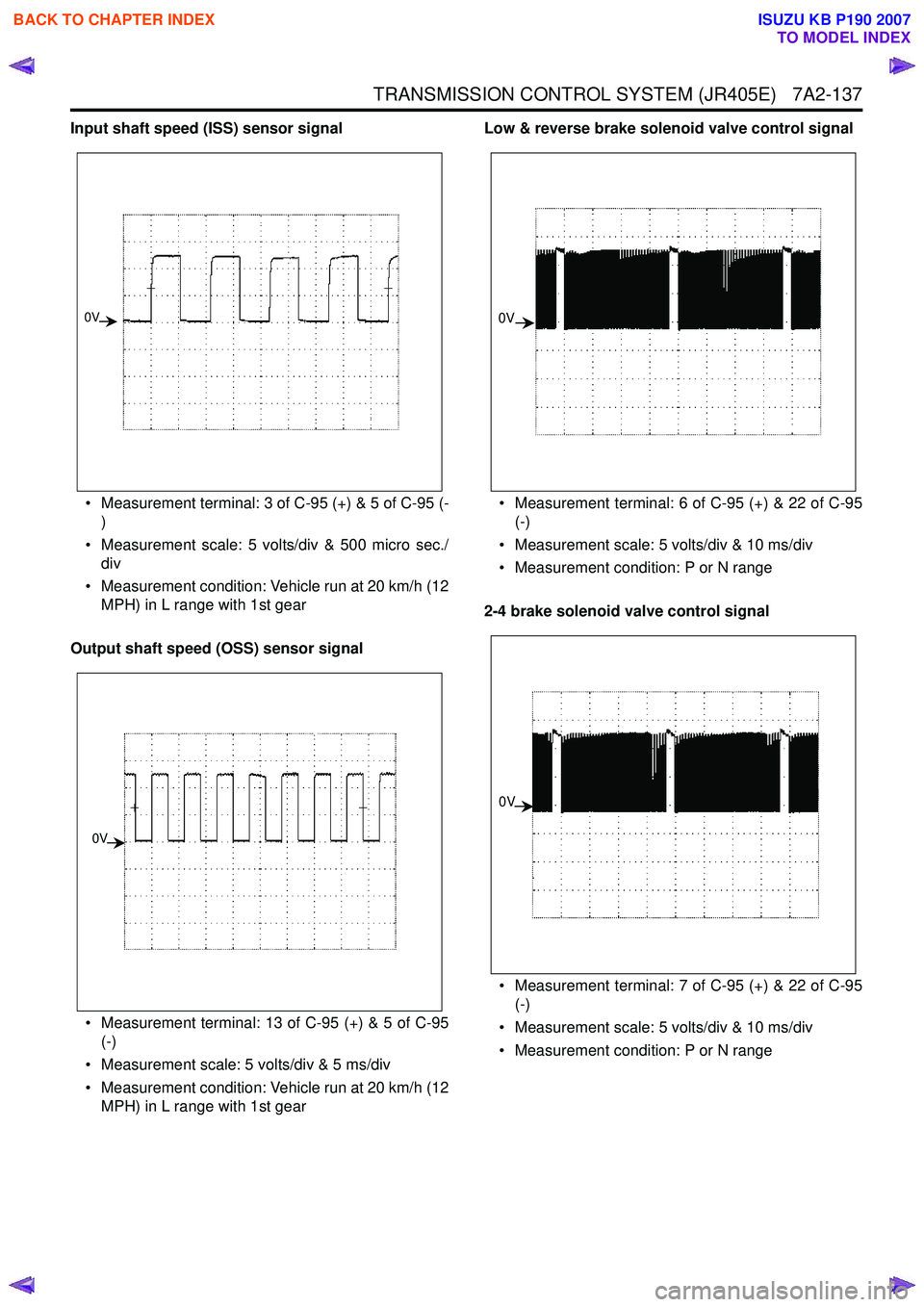
TRANSMISSION CONTROL SYSTEM (JR405E) 7A2-137
Input shaft speed (ISS) sensor signal• Measurement terminal: 3 of C-95 (+) & 5 of C-95 (- )
• Measurement scale: 5 volts/div & 500 micro sec./ div
• Measurement condition: Vehicle run at 20 km/h (12 MPH) in L range with 1st gear
Output shaft speed (OSS) sensor signal
• Measurement terminal: 13 of C-95 (+) & 5 of C-95 (-)
• Measurement scale: 5 volts/div & 5 ms/div
• Measurement condition: Vehicle run at 20 km/h (12 MPH) in L range with 1st gear Low & reverse brake solenoid valve control signal
• Measurement terminal: 6 of C-95 (+) & 22 of C-95 (-)
• Measurement scale: 5 volts/div & 10 ms/div
• Measurement condition: P or N range
2-4 brake solenoid valve control signal
• Measurement terminal: 7 of C-95 (+) & 22 of C-95 (-)
• Measurement scale: 5 volts/div & 10 ms/div
• Measurement condition: P or N range
0V
0V
0V
0V
BACK TO CHAPTER INDEX
TO MODEL INDEX
ISUZU KB P190 2007
Page 4428 of 6020
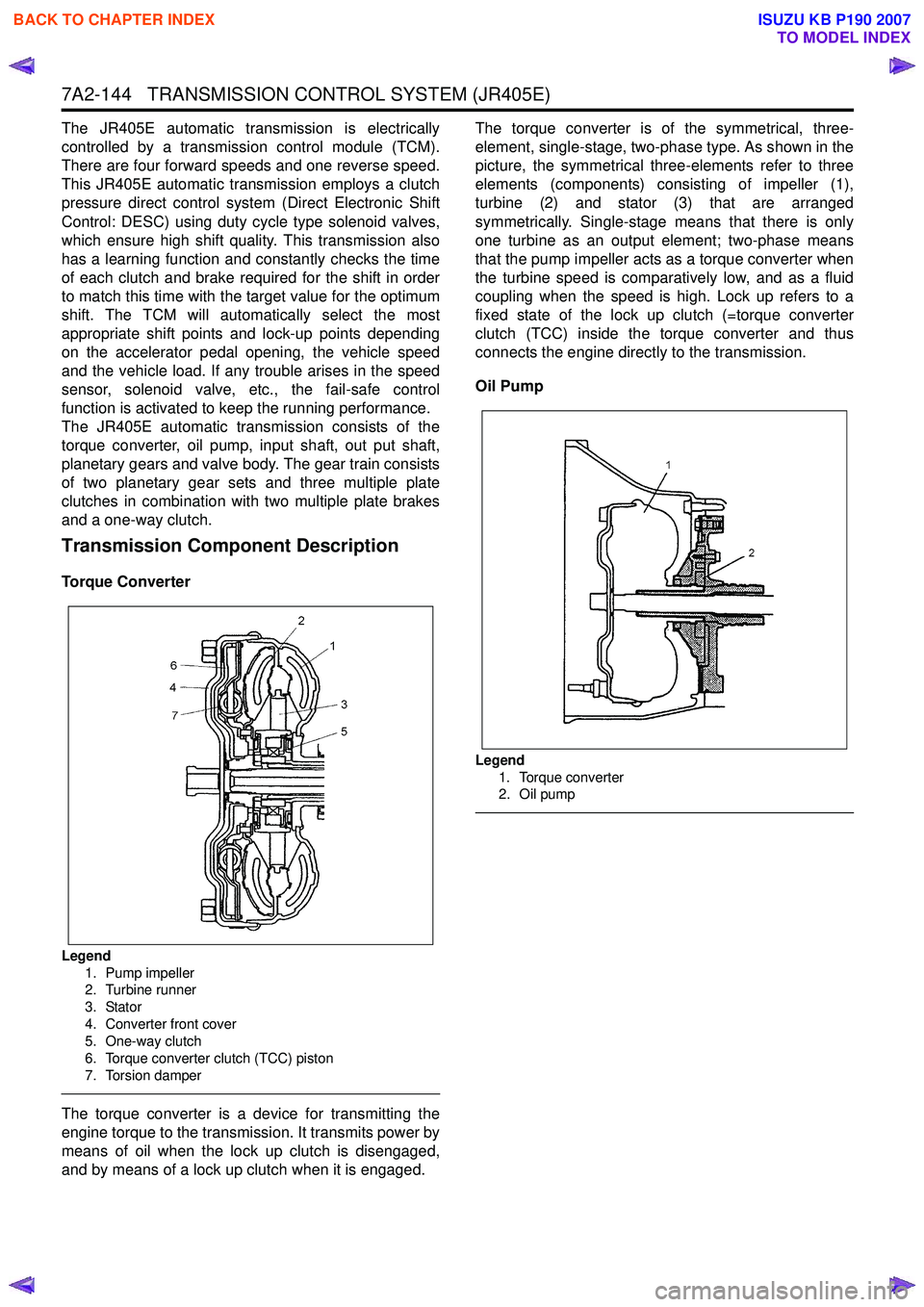
7A2-144 TRANSMISSION CONTROL SYSTEM (JR405E)
The JR405E automatic transmission is electrically
controlled by a transmission control module (TCM).
There are four forward speeds and one reverse speed.
This JR405E automatic transmission employs a clutch
pressure direct control system (Direct Electronic Shift
Control: DESC) using duty cycle type solenoid valves,
which ensure high shift quality. This transmission also
has a learning function and constantly checks the time
of each clutch and brake required for the shift in order
to match this time with the target value for the optimum
shift. The TCM will automatically select the most
appropriate shift points and lock-up points depending
on the accelerator pedal opening, the vehicle speed
and the vehicle load. If any trouble arises in the speed
sensor, solenoid valve, etc., the fail-safe control
function is activated to keep the running performance.
The JR405E automatic transmission consists of the
torque converter, oil pump, input shaft, out put shaft,
planetary gears and valve body. The gear train consists
of two planetary gear sets and three multiple plate
clutches in combination with two multiple plate brakes
and a one-way clutch.
Transmission Component Description
Torque Converter
Legend
1. Pump impeller
2. Turbine runner
3. Stator
4. Converter front cover
5. One-way clutch
6. Torque converter clutch (TCC) piston
7. Torsion damper
The torque converter is a device for transmitting the
engine torque to the transmission. It transmits power by
means of oil when the lock up clutch is disengaged,
and by means of a lock up clutch when it is engaged. The torque converter is of the symmetrical, three-
element, single-stage, two-phase type. As shown in the
picture, the symmetrical three-elements refer to three
elements (components) consisting of impeller (1),
turbine (2) and stator (3) that are arranged
symmetrically. Single-stage means that there is only
one turbine as an output element; two-phase means
that the pump impeller acts as a torque converter when
the turbine speed is comparatively low, and as a fluid
coupling when the speed is high. Lock up refers to a
fixed state of the lock up clutch (=torque converter
clutch (TCC) inside the torque converter and thus
connects the engine directly to the transmission.
Oil Pump
Legend 1. Torque converter
2. Oil pump
BACK TO CHAPTER INDEX
TO MODEL INDEX
ISUZU KB P190 2007
Page 4432 of 6020
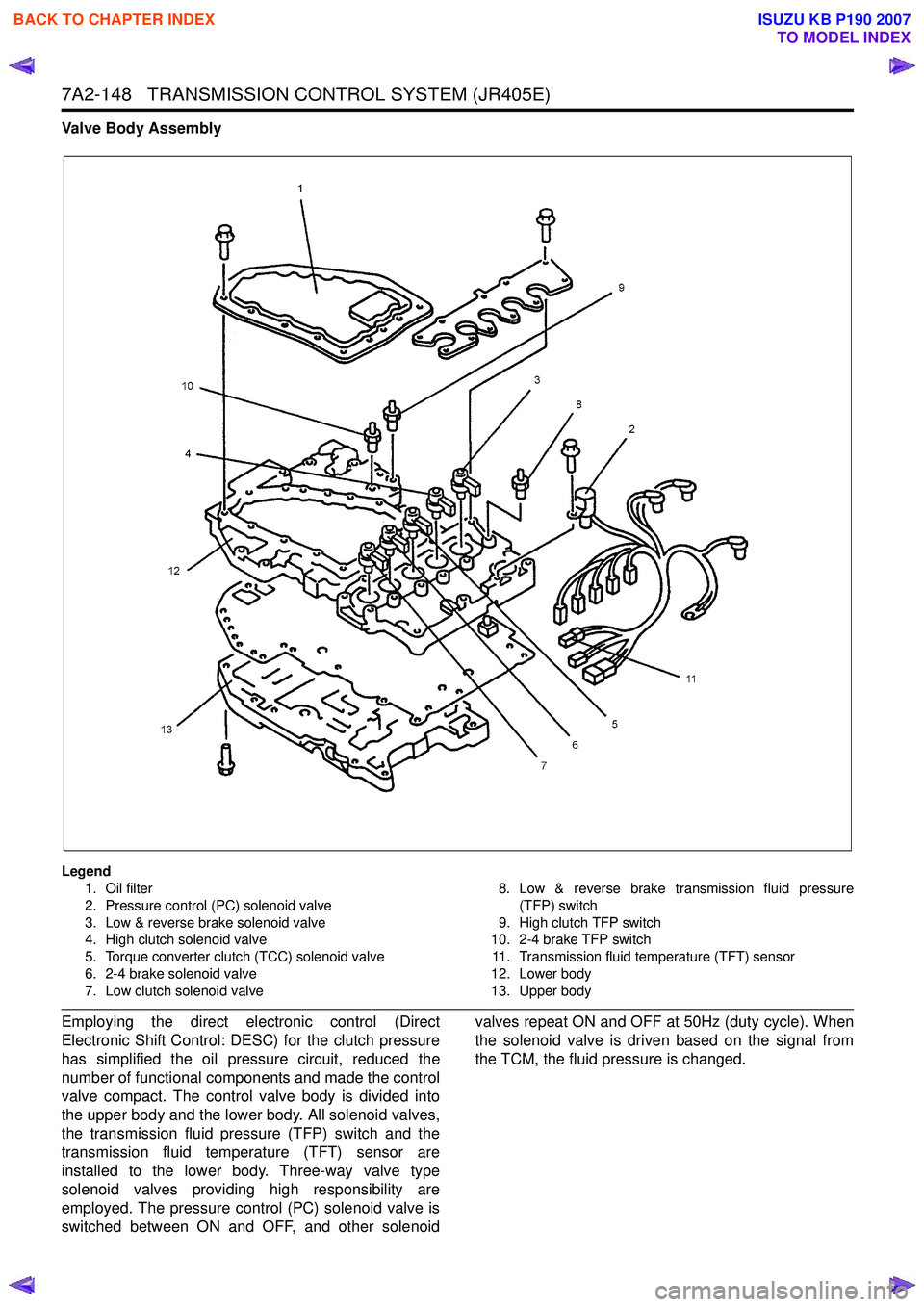
7A2-148 TRANSMISSION CONTROL SYSTEM (JR405E)
Valve Body Assembly
Legend1. Oil filter
2. Pressure control (PC) solenoid valve
3. Low & reverse brake solenoid valve
4. High clutch solenoid valve
5. Torque converter clutch (TCC) solenoid valve
6. 2-4 brake solenoid valve
7. Low clutch solenoid valve 8. Low & reverse brake transmission fluid pressure
(TFP) switch
9. High clutch TFP switch
10. 2-4 brake TFP switch
11. Transmission fluid temperature (TFT) sensor
12. Lower body
13. Upper body
Employing the direct electronic control (Direct
Electronic Shift Control: DESC) for the clutch pressure
has simplified the oil pressure circuit, reduced the
number of functional components and made the control
valve compact. The control valve body is divided into
the upper body and the lower body. All solenoid valves,
the transmission fluid pressure (TFP) switch and the
transmission fluid temperature (TFT) sensor are
installed to the lower body. Three-way valve type
solenoid valves providing high responsibility are
employed. The pressure control (PC) solenoid valve is
switched between ON and OFF, and other solenoid valves repeat ON and OFF at 50Hz (duty cycle). When
the solenoid valve is driven based on the signal from
the TCM, the fluid pressure is changed.
BACK TO CHAPTER INDEX
TO MODEL INDEX
ISUZU KB P190 2007
Page 4433 of 6020
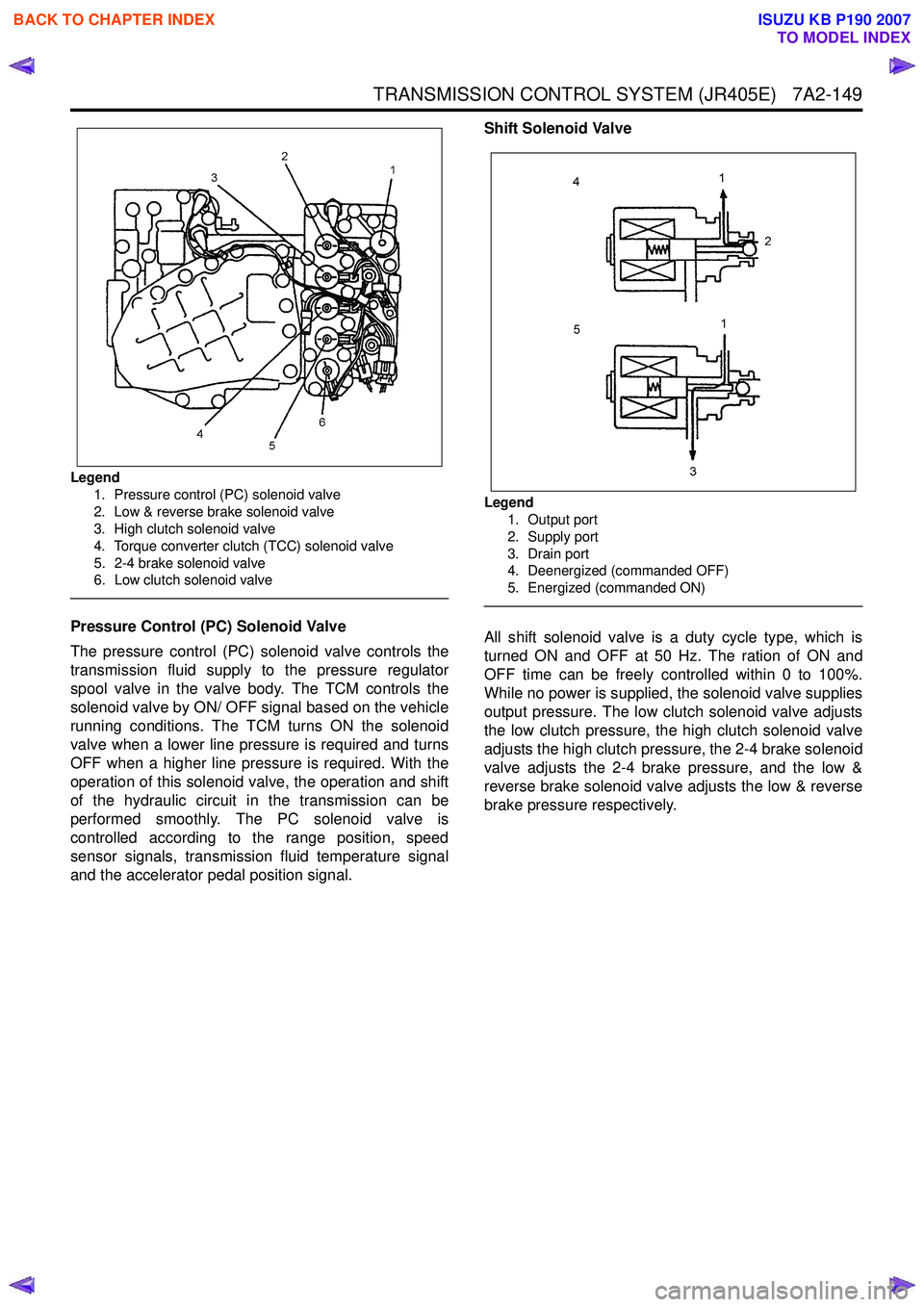
TRANSMISSION CONTROL SYSTEM (JR405E) 7A2-149
Legend1. Pressure control (PC) solenoid valve
2. Low & reverse brake solenoid valve
3. High clutch solenoid valve
4. Torque converter clutch (TCC) solenoid valve
5. 2-4 brake solenoid valve
6. Low clutch solenoid valve
Pressure Control (PC) Solenoid Valve
The pressure control (PC) solenoid valve controls the
transmission fluid supply to the pressure regulator
spool valve in the valve body. The TCM controls the
solenoid valve by ON/ OFF signal based on the vehicle
running conditions. The TCM turns ON the solenoid
valve when a lower line pressure is required and turns
OFF when a higher line pressure is required. With the
operation of this solenoid valve, the operation and shift
of the hydraulic circuit in the transmission can be
performed smoothly. The PC solenoid valve is
controlled according to the range position, speed
sensor signals, transmission fluid temperature signal
and the accelerator pedal position signal. Shift Solenoid Valve
Legend
1. Output port
2. Supply port
3. Drain port
4. Deenergized (commanded OFF)
5. Energized (commanded ON)
All shift solenoid valve is a duty cycle type, which is
turned ON and OFF at 50 Hz. The ration of ON and
OFF time can be freely controlled within 0 to 100%.
While no power is supplied, the solenoid valve supplies
output pressure. The low clutch solenoid valve adjusts
the low clutch pressure, the high clutch solenoid valve
adjusts the high clutch pressure, the 2-4 brake solenoid
valve adjusts the 2-4 brake pressure, and the low &
reverse brake solenoid valve adjusts the low & reverse
brake pressure respectively.
BACK TO CHAPTER INDEX
TO MODEL INDEX
ISUZU KB P190 2007
Page 4434 of 6020
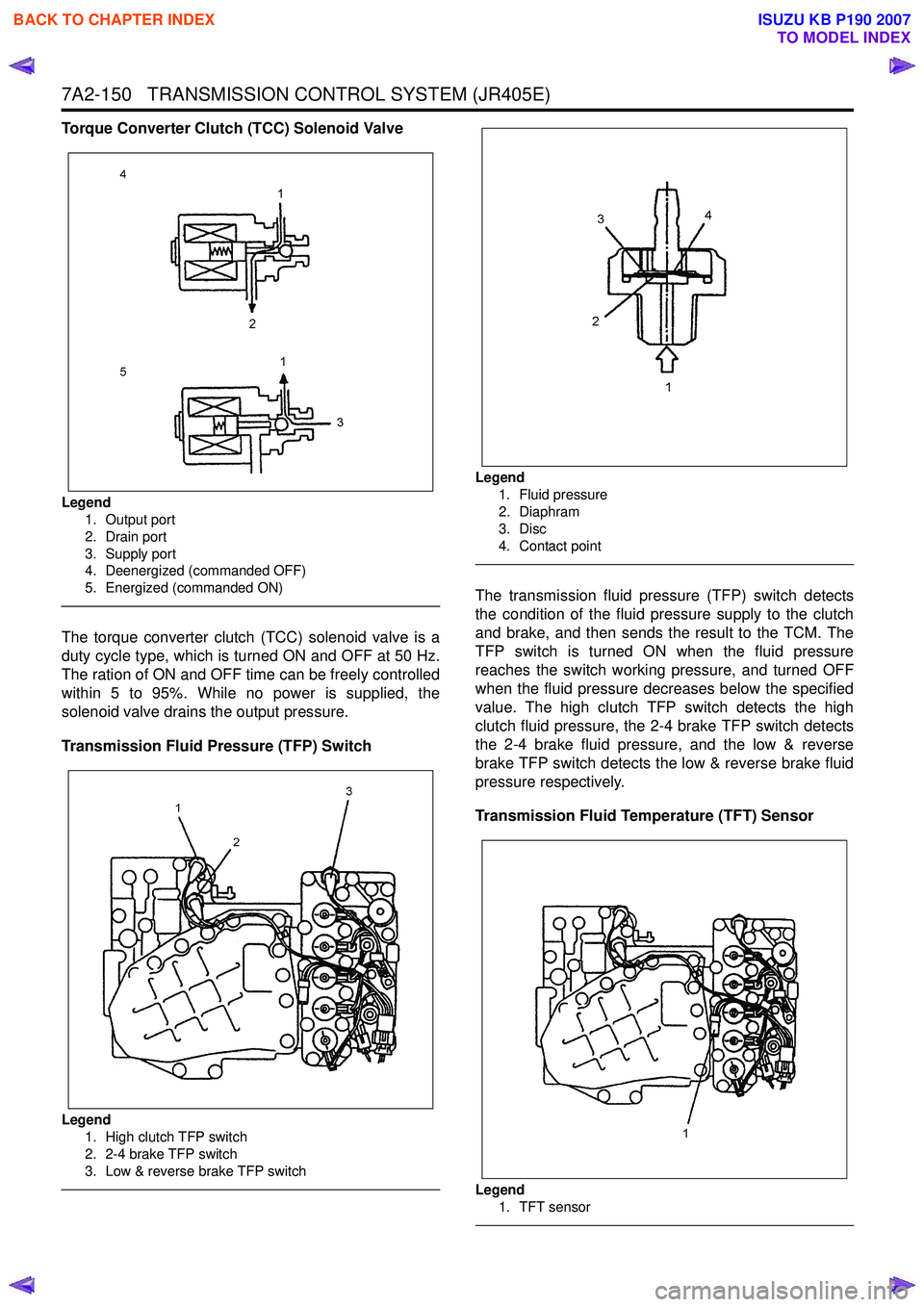
7A2-150 TRANSMISSION CONTROL SYSTEM (JR405E)
Torque Converter Clutch (TCC) Solenoid Valve
Legend1. Output port
2. Drain port
3. Supply port
4. Deenergized (commanded OFF)
5. Energized (commanded ON)
The torque converter clutch (TCC) solenoid valve is a
duty cycle type, which is turned ON and OFF at 50 Hz.
The ration of ON and OFF time can be freely controlled
within 5 to 95%. While no power is supplied, the
solenoid valve drains the output pressure.
Transmission Fluid Pressure (TFP) Switch
Legend 1. High clutch TFP switch
2. 2-4 brake TFP switch
3. Low & reverse brake TFP switch
Legend
1. Fluid pressure
2. Diaphram
3. Disc
4. Contact point
The transmission fluid pressure (TFP) switch detects
the condition of the fluid pressure supply to the clutch
and brake, and then sends the result to the TCM. The
TFP switch is turned ON when the fluid pressure
reaches the switch working pressure, and turned OFF
when the fluid pressure decreases below the specified
value. The high clutch TFP switch detects the high
clutch fluid pressure, the 2-4 brake TFP switch detects
the 2-4 brake fluid pressure, and the low & reverse
brake TFP switch detects the low & reverse brake fluid
pressure respectively.
Transmission Fluid Temperature (TFT) Sensor
Legend
1. TFT sensor
BACK TO CHAPTER INDEX
TO MODEL INDEX
ISUZU KB P190 2007